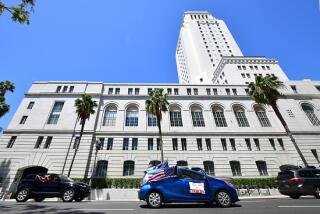Clinton Forwarded Donor’s Request for U.S. Backing
- Share via
WASHINGTON — President Clinton asked a senior White House official to look into whether the United States should support an international business venture of a major Democratic campaign contributor after the donor approached him about it at a White House reception last year, administration officials said Tuesday.
Clinton directed senior advisor Thomas F. “Mack” McLarty to make inquiries and report back after Roger Tamraz, a Lebanese-American oil financier, made a personal pitch at a March 1996 reception for political donors arranged by the Democratic National Committee. Tamraz wanted the administration’s backing for an ambitious plan to develop a pipeline from the rich oil fields of the Caspian Sea basin across the Caucuses and into Turkey.
McLarty contacted officials at the Department of Energy and quickly found that Tamraz’s project long since had been reviewed and rejected at lower levels of the administration. In fact, officials at the National Security Council felt so strongly about Tamraz that they had tried and failed months earlier to block his access to Clinton at White House fund-raising events.
McLarty soon reported back to Clinton that there was nothing further the United States could do to aid Tamraz.
But the episode, described by the White House on Tuesday in response to inquiries about Tamraz’s political access, provides a clear example of how major Democratic contributors sought to use campaign access to benefit their private business interests--and how administration officials, including the president, responded.
The White House revelation about Tamraz’s private discussion with Clinton came long after Tamraz surfaced as a controversial figure in the campaign fund-raising scandal. White House officials said documents related to the meeting had just been uncovered.
Tamraz has been described as a master at using campaign donations and other forms of influence to circumvent normal policy processes and to make an end run around officials who already had turned him down. He gave at least $177,000 to the Democrats.
Tamraz’s brief conversation with Clinton came during a March 27, 1996, White House dinner for Democratic donors, according to White House spokesman Lanny Davis. Either in a receiving line or while Clinton was mingling with the crowd of about 120 supporters, Tamraz approached the president and asked for his help, White House officials said.
Clinton’s social secretary, who was following him, jotted down notes from the conversation, including a notation that someone on the White House staff should follow up. Clinton asked McLarty, apparently the next day.
A former energy company executive, McLarty checked into the status of Tamraz’s proposal with Energy Department officials. McLarty’s inquiry clearly caught them off-guard, since they had rejected Tamraz’s entreaties a year earlier.
As previously reported, Tamraz met with Energy Department official Jack Carter in May 1995 to discuss his pipeline proposal. With the help of U.S. Ambassador to Armenia Harry Gilmore, Tamraz also arranged meetings with senior State Department officials. And that June, Tamraz met with Sheila Heslin, the NSC’s expert on the Caucuses.
The State, Energy and NSC officials all listened to Tamraz but did nothing in support of his proposal. Administration officials favored building a pipeline across the Caucuses from the Caspian oil fields to end an existing Russian monopoly on shipment of oil out of the region. But they did not think Tamraz was the man to do it.
McLarty’s call to the Energy Department apparently prompted Carter to call Heslin. White House officials said Tuesday night that Heslin believed that Carter--in the wake of McLarty’s call--was trying to pressure her into changing her opposition to Tamraz and his pipeline proposal. White House officials said that Heslin “stood her ground” and informed her superior, NSC staff director Nancy Soderberg, of Carter’s pressure.
Soderberg backed up Heslin, the White House said, and echoed Heslin’s fear that U.S. policy might be affected by Tamraz’s renewed lobbying efforts.
Yet the White House insisted Tuesday that Tamraz’s efforts to circumvent normal administration processes made no difference in the way the government dealt with his proposal.
“Roger Tamraz visited the White House on several occasions in 1995 and ’96 during a period in which he was seeking support for his plan for a pipeline,” said Davis. “U.S. policy had been established prior to this time and has remained constant.”
Still, Heslin had been fending off Tamraz for months. In the fall of 1995, she had tried to oppose Tamraz’s visits to the White House, prompting Tamraz to tell then-DNC Chairman Don Fowler that the Central Intelligence Agency would vouch for him. Tamraz had developed ties to the CIA when he was a contact for the Lebanese government with Israel in the early 1980s.
Fowler called the CIA and asked that it send a memo about Tamraz to Heslin.
The former Democratic chairman’s contacts with the CIA are now under investigation by the Justice Department and the CIA’s inspector general. Ultimately, Tamraz was able to visit the White House complex on seven occasions, including six social events for campaign donors.
In July 1995, after his unproductive meetings at State, Energy and the NSC, Tamraz began contributing generously to the Democratic Party, ultimately giving at least $177,000 to the DNC and state parties, and pledging to give several times more. His large donations and pledges prompted the Democratic National Committee to push for access for him to White House events with Clinton.
More to Read
Get the L.A. Times Politics newsletter
Deeply reported insights into legislation, politics and policy from Sacramento, Washington and beyond. In your inbox twice per week.
You may occasionally receive promotional content from the Los Angeles Times.










